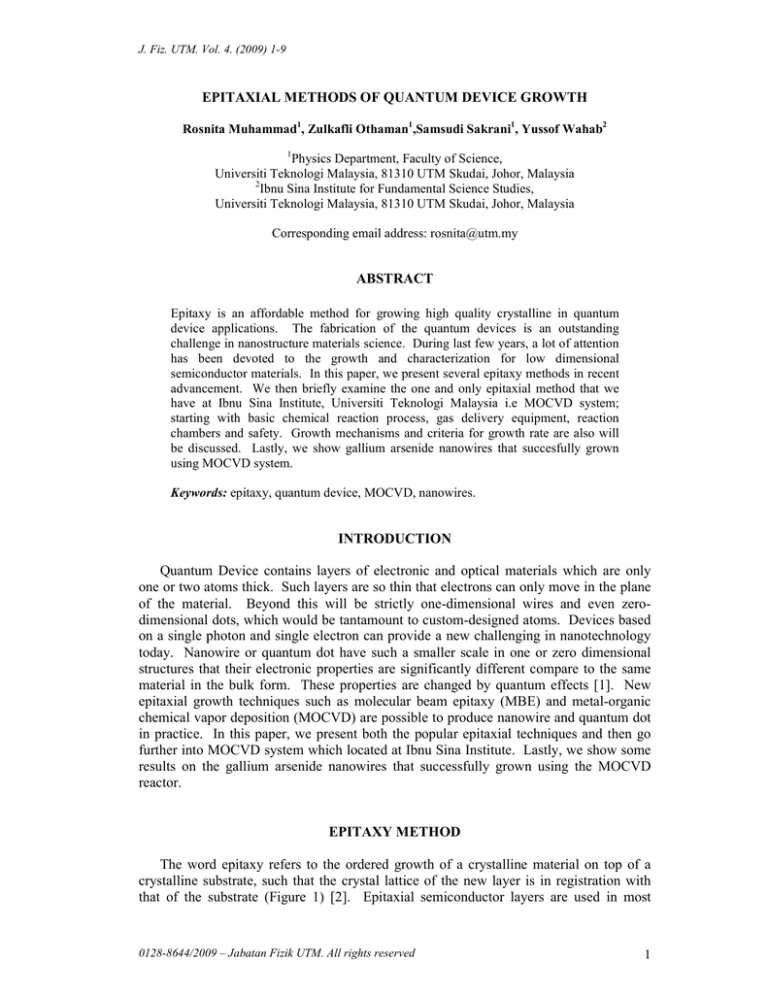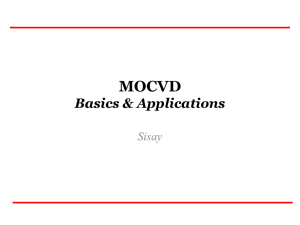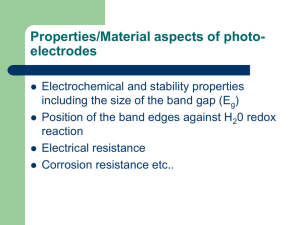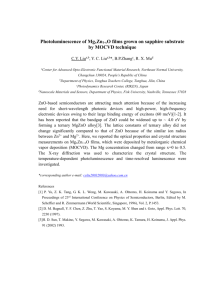
J. Fiz. UTM. Vol. 4. (2009) 1-9
EPITAXIAL METHODS OF QUANTUM DEVICE GROWTH
Rosnita Muhammad1, Zulkafli Othaman1,Samsudi Sakrani1, Yussof Wahab2
1
Physics Department, Faculty of Science,
Universiti Teknologi Malaysia, 81310 UTM Skudai, Johor, Malaysia
2
Ibnu Sina Institute for Fundamental Science Studies,
Universiti Teknologi Malaysia, 81310 UTM Skudai, Johor, Malaysia
Corresponding email address: rosnita@utm.my
ABSTRACT
Epitaxy is an affordable method for growing high quality crystalline in quantum
device applications. The fabrication of the quantum devices is an outstanding
challenge in nanostructure materials science. During last few years, a lot of attention
has been devoted to the growth and characterization for low dimensional
semiconductor materials. In this paper, we present several epitaxy methods in recent
advancement. We then briefly examine the one and only epitaxial method that we
have at Ibnu Sina Institute, Universiti Teknologi Malaysia i.e MOCVD system;
starting with basic chemical reaction process, gas delivery equipment, reaction
chambers and safety. Growth mechanisms and criteria for growth rate are also will
be discussed. Lastly, we show gallium arsenide nanowires that succesfully grown
using MOCVD system.
Keywords: epitaxy, quantum device, MOCVD, nanowires.
INTRODUCTION
Quantum Device contains layers of electronic and optical materials which are only
one or two atoms thick. Such layers are so thin that electrons can only move in the plane
of the material. Beyond this will be strictly one-dimensional wires and even zerodimensional dots, which would be tantamount to custom-designed atoms. Devices based
on a single photon and single electron can provide a new challenging in nanotechnology
today. Nanowire or quantum dot have such a smaller scale in one or zero dimensional
structures that their electronic properties are significantly different compare to the same
material in the bulk form. These properties are changed by quantum effects [1]. New
epitaxial growth techniques such as molecular beam epitaxy (MBE) and metal-organic
chemical vapor deposition (MOCVD) are possible to produce nanowire and quantum dot
in practice. In this paper, we present both the popular epitaxial techniques and then go
further into MOCVD system which located at Ibnu Sina Institute. Lastly, we show some
results on the gallium arsenide nanowires that successfully grown using the MOCVD
reactor.
EPITAXY METHOD
The word epitaxy refers to the ordered growth of a crystalline material on top of a
crystalline substrate, such that the crystal lattice of the new layer is in registration with
that of the substrate (Figure 1) [2]. Epitaxial semiconductor layers are used in most
0128-8644/2009 – Jabatan Fizik UTM. All rights reserved
1
J. Fiz. UTM. Vol. 4. (2009) 1-9
semiconductor device fabrication processes because of the ability to accurately control
the crystal composition and doping concentration and to form atomically abrupt heterointerfaces. The techniques for epitaxial growth have typically been divided into processes
that deliver the molecules for crystal growth in the liquid phase (LPE), in the gas phase,
or processes that deliver the molecules in a vacuum chamber in molecular beams.
Depending on the technique, the atoms for crystal growth arrive as elemental species or
within precursor molecules that thermally or chemically decomposed on the surface to
leave the desired species for epitaxy.
Figure 1 : The ordered epitaxial growth of a crystalline material on a substrate.
Various technique are used for growing epitaxial layer but the new crystal growth
techniques have been used are molecular beam epitaxy, MBE [3-4] and metalorganic
chemical vapor deposition, MOCVD [5-6]. MOCVD is also referred to, and used
interchangeably with, MOVPE/OMVPE (metallorganic/organometallic vapor phase
epitaxy). MOCVD is a broader term that is applicable to the deposition of crystal,
polycrystalline and amorphous materials. Both MBE and MOCVD have produce a wide
range of very high-purity semiconductor materials with excellent optical and electrical
properties [7].
Molecular beam epitaxy (MBE)
Molecular Beam Epitaxy (MBE) is an Ultra-High-Vacuum (UHV)-based technique
for producing high quality epitaxial structures with a monolayer (ML) control. Since its
introduction in the 1970s as a tool for growing high-purity semiconductor films, MBE has
evolved into one of the most widely used techniques for producing epitaxial layers of
metals, insulators and superconductors as well, both at the research and the industrial
production level. The principle underlying MBE growth is relatively simple: it consists
essentially of atoms or clusters of atoms, which are produced by heating up a solid source.
The clusters then migrate in an UHV environment and impinge on a hot substrate surface,
where diffusion process occurred and incorporate into the growing film (Figure 2).
The growth of uniform epitaxial films from multiple effusion cells requires special
effusion cell geometry and continuous rotation of the substrate around an axis normal to
the substrate surface. The substrate holder can rotate with speeds up to 125 rpm. The
control unit remotely orients the sample holder into any of hour positions: growth,
transfer, E-beam and auxiliary [8]. The controller also allows remote to adjust the speed
rotation. The modern commercial MBE growth chamber (Figure 3) is often equipped
with a rotary substrate manipulator capable of turning the substrate azimuthally during
0128-8644/2009 – Jabatan Fizik UTM. All rights reserved
2
J. Fiz. UTM. Vol. 4. (2009) 1-9
growth. With this feature the substrate can be heated more uniformly and resulting the
uniformity and good layers structure [9].
Figure 2 : MBE cut-away system viewed from the top [8]
Figure 3 : MBE System at MIT, Cambridge
0128-8644/2009 – Jabatan Fizik UTM. All rights reserved
3
J. Fiz. UTM. Vol. 4. (2009) 1-9
Metal Organic Chemical Vapor Deposition (MOCVD)
MOCVD is the epitaxial crystal growth technology of choice for an impressive array
of commercial devices, including lasers, light emitting diodes (LED), heterostructure
bipolar transistors, photodetectors and solar cells. The growth process in MOCVD is
similar to MBE, but the atoms are carried in gaseous form to the substrate (Figure 4). For
example, to grow epitaxial GaAs, the gasses can be trimethyl gallium and arsine. These
precursor molecules thermally decomposed on a hot substrate, the resulting organic
molecules evaporate, leaving the Ga and As atoms for incorporation into the crystal.
Typical growth temperatures are in the range 340 - 570oC, and the growth rates are onthe-order-of 1 molecular layer of GaAs per second. This growth rate allows the precursor
gasses to be switched quickly enough to give very abrupt material interfaces. The growth
process given by;
(CH3)3Ga + AsH3 GaAs + 3CH4
(1)
Figure 4 : Schematic view of a MOCVD reactor
The most important organometallic compounds that have been studied are
trimethylgallium (TMGa), trimethylaluminium (TMAl) and trimethylindium (TMIn).
These sources should be easily synthesized and easily purified related to practicalities of
using several different sources together [James Coleman, 1997]. In general, the
organometallic constituents are transported to the heated substrate by passing a carrier gas,
usually hydrogen or nitrogen or a mixture of the two, through the compound contained in
a constant-temperature bubbler vessel. Most MOCVD growth of III-V compound
semiconductors and alloys involves the use of hydrides, such as arsine or phosphine, for
the column V species because they are already gases and supplied from simple cylinder.
MOCVD reactors consist of three major components; the reactor gas delivery system,
the reaction chamber and the reactor safety infrastructure. The reactor delivery system or
gas panel is a very clean, leak-free network of stainless-steel tubing, automatic valves and
electronic mass flow controllers as shown in Figure 5. Hydride delivery modules
generally require a few valves and an electronic mass flow controller, since these sources
are already provided as dilute, high pressure gases in gas cylinders. An important part of
the main gas panel is the supply of carrier gases within a vent-run configuration.
0128-8644/2009 – Jabatan Fizik UTM. All rights reserved
4
J. Fiz. UTM. Vol. 4. (2009) 1-9
Figure 5 : Schematic diagram of MOCVD reactor delivery system gas panel,
illustrating hydride delivery modules, alkyl delivery modules and the vent-run
configuration.
The reaction chamber is a vessel in which the source gases are mixed, introduced into
a heated zone where an appropriate substrate is located, and the basic pyrolysis reactions
take place. There are two basic reaction-chamber geometries [10] commonly used for the
MOCVD growth of optoelectronic materials, Figure 6. Both designs are cold-wall
systems that reflect the basic pyrolysis nature of the process and make use of an indirectly
heated (radio-frequency induction heated or infrared radiant heated) silicon carbidecoated graphited susceptor. The chamber itself can be quartz, stainless steel or quartzlined stainless steel.
Figure 6 : Two common chamber geometry designs for MOCVD.
(a) Vertical design (b) Horizontal design
Safety is of paramount importance in the design and operation of MOCVD growth
apparatus whether the sources used are hydride or not [11]. Hydrides pose the biggest
risk because they are high-pressure toxic gases. The alkyls pose the next highest risk
because, although they are toxic and pyrophoric, they are liquids and generally easier to
handle. Ancillary risks include quartz reaction chambers (which are breakable), large
volumes of explosive hydrogen gas, high temperatures, and the acids and solvents used
for preparing for, and cleaning up after, a growth run. Handling these risks, falls into
0128-8644/2009 – Jabatan Fizik UTM. All rights reserved
5
J. Fiz. UTM. Vol. 4. (2009) 1-9
three categories applies equally well to all epitaxial growth process indeed to all
semiconductor processing activities. The first is limited access, requires a higher level of
authority and a correspondingly higher level of training. The second is training which
required emergency-response situations such as hazardous-materials response and the
third category is a hardware safety infrastructure. Automatic shutdown of gases source
and a switch to purge inert gases should take place in the event of power failure when
inadequate backup power is available.
The hydrodynamics of the reactor geometry play a key role in the nature of the
process for MOCVD growth. In practical reactors, a large mismatch often exists between
the inlet tube, which typically is a standard tube size of less than 10mm diameter and the
characteristic dimensions of the reaction chamber. Thus, even in a relatively simple
horizontal reaction chamber, the gas may have to travel well into the chamber before a
simple parabolic profile stabilizes. A heated zone is necessary to drive the pyrolysis
reaction and provide for the desired materials deposition. The temperature gradient
between the susceptor and the chamber ambient can be very large, often several hundreds
of degrees Celsius. For example, the optimum MOCVD growth temperature for many
III-V compunds and alloys falls in the range of 600-800oC. Air or water cooling is often
used to maintain the chamber walls at temperature close to room temperature.
MOCVD at Ibnu Sina Institute (IIS), UTM
Ibnu Sina Institute, UTM gearing up the research by moving forward on state-of theart equipment on MOCVD system and since now, it was the first IPTA’s in Malaysia
which well equipped with MOCVD system. The system has been installed on Feb 2007
and the hands on training a week after. Figure 7 shows the author operated the MOCVD
system which located at Ibnu Sina Institute Cleanroom.
Figure 7: The author with the MOCVD system at IIS, UTM. Picture on the right side is the
vertical chamber which the sources gas mixed to produce epitaxial layer (in front of the author).
Constant source delivery is critical for thin quantum well optoelectronic devices and
will have implications in the growth of thicker heterostructures in materials system that
must be lattice matched. Small changes in a flow carrier gas can significantly change the
source delivery. Therefore, the design of gas delivery systems must avoid transients from
switching or dead space (Figure 8). The reactor delivery system must be very clean, leak
free, stainless-steel tubing and automatic valves.
0128-8644/2009 – Jabatan Fizik UTM. All rights reserved
6
J. Fiz. UTM. Vol. 4. (2009) 1-9
Figure 8 : MOCVD reactor delivery system with manifold gas panel.
RESULTS AND DISCUSSIONS
One of the successfully results growth using our MOCVD reactor was the growth of
gallium arsenide (GaAs) nanowire on GaAs substrate using vapor-liquid solid (VLS)
mechanism. By this technique, free-standing crystalline nanowires of semiconductor with
fully control nucleation sites and diameter from pre-formed metal catalyst can be grown.
The growth of GaAs nanowire on GaAs substrate at 420oC was carried out using
trimethylgallium (TMGa) and 10% Arsine. The sources were carried out by purity
hydrogen gases throughout the palladium purifier. Figure 9 shows the MOCVD process
flow of GaAs nanowire. Basically, it contains 4 different steps. The first step is
susceptor bake which is done at lower temperature, usually at 200oC for 3 min. The
second step is colloidal gold annealing process. This process is priority for the formation
of eutectic temperature alloy between Ga and gold and during this step, AsH3 gas
overpressure supplied. The next step is the GaAs nanowire growth. Before the TMGa
and AsH3 sources inject to the chamber, the flow source of the trimethyl gases need to
stabilize in the line usually for 5 min. The gas source supply rates for TMGa and AsH3
were at 1.0 and 25 sccm respectively. The last step is cooling down the substrate to zero
degree or room temperature with AsH3 flow overpressure supplied for 10 min to the
substrate surface.
Figure 9 : MOCVD flow process of GaAs nanowire
0128-8644/2009 – Jabatan Fizik UTM. All rights reserved
7
J. Fiz. UTM. Vol. 4. (2009) 1-9
The GaAs nanowires was observed using Transmission Electron Microscopy (TEM)
for crystal structure characterization. GaAs nanowires firstly, were broken off from the
substrate surface by putting a specimen in a vial bottle contained acetone and sonicated
for 20 min. A small (~5µl) of the solution was then pipette onto a standard TEM copper
carbon holey grid. The result was shown in Figure 10. The nanowire was of zinc blende
structure. The inset shows a high-resolution TEM image of the wire with highly epitaxial
layers grown by layered in periodic scale and less defect formed. The measured lattice
spacing perpendicular to the nanowire axis (indicate by arrow) is 0.328 nm, consistent
with the (111) planar spacing of 0.326 nm for bulk GaAs [12].
Figure 10 : Transmission Electron Microscopy image of GaAs nanowire grown at 420oC
SUMMARY
We have attempted to capture the essence of the epitaxial methods for quantum
devices growth by focusing on MBE and MOCVD. We describe and examine deeper on
MOCVD by considering basic chemical reactions, the TMGa and TMIn metal organic
sources, the safety and the chamber reactor where the chemical reaction takes place. It is
worth adding a few words to address the competition between MOCVD and MBE which
are fundamentally very different. The first is that, in the hands of experts, both processes
can produce similar results, and the limitations are generally those fundamental to the
materials chosen rather the utilized process. The second is that, the development of each
process has been accelerated by advances in the other, to the point where both processes,
as well as the technical community in general, are the better for the competition.
ACKNOWLEDGEMENTS
The authors acknowledge the Ministry of Science, Technology and Environment
Malaysia for the financial support through IRPA funding 09-02-06-0156-SR0013/06-01.
0128-8644/2009 – Jabatan Fizik UTM. All rights reserved
8
J. Fiz. UTM. Vol. 4. (2009) 1-9
Besides, the authors also acknowledge the Ibnu Sina Institute for lab facilities especially
MOCVD system.
REFERENCES
1.
2.
3.
4.
5.
6.
7.
8.
9.
10.
11.
12.
13.
Henini, M. Self-Assembled QDs for Optoelectronic Devices: Progress and
Challenges. Research on Integrated Quantum Electronics. 2004. 3: 97 – 110.
Eric Donkor. GaAs-Based Nanodevices. Encyclopedia of Nanoscience and
Nanotechnology. 2004. 3: 703-717.
Liang, B. L. Wang, Z. M. Mazur, Y. I. Strelchuck, V. V. Holmes, K. Lee, J. H.
Salamo, G. J. InGaAs Quantum Dots Grown on B-type High Index GaAs
Substrates: Surface Morphologies and Optical Properties. Nanotechnology. 2006. 17
(11): 2736-2740.
Der-Cherng Liu, Chien-Ping Lee and Shyi-Long Shy. Fabrication of Quantum Dots
Using In-situ Etching and Regrowth During MBE Growth. Electron Devices
Meeting. 1993: 427-429
Krost , A., Heinrichsdorff , F., Bimberg , D., Bläsing, J., Darhuber , A. and Bauer, G.
X-Ray Analysis of Self-Organized InAs/InGaAs Quantum Dot Structure. Cryst. Res.
Technology. 1999. 34(1): 89-102.
James J. Coleman. MOCVD for Optoelectronic Devices. Proc. of The IEEE.
November 1997. 85(11): 1715-1730.
Arakawa, Y. Fabrication of Self-Assembling QDs for Photonic Devices Appl. Proc.
of the 1st Symposium on Atomic Scale Surface and Interface Dynamics. March 1314, 1997.
Chang, C. Y. and Francis Kai. GaAs High-Speed Devices. John Wiley & Sons. 1994.
Lee, S. C., Dawson, L. R. and Brueck, S.R. J. Appl. Phys. Lett. 2005. 87, 071110.
Manasevit, H. M. Single-crystal Gallium Arsenide on Insulating Substrates. Appl.
Phys. Lett. 1968. 12(4): 156-159.
Johnson, E., Tsui, R., Convey, D., Mellen, N. and Curless, J. A MOCVD Reactor
Safety System for a Production Environment. Journal of Crystal Growth. 1984.
68(1): 497-501.
Wu, Z. H., Mei, X., Kim, D., Blumin, M., Ruda, H. E., Liu, J. Q., Kavanagh, K. L.
Growth, Branching and Kinking of Molecular-Beam Epitaxial <110> GaAs
Nanowires. Appl. Phys. Lett. 2003. 83:3368.
Hiruma, K., Yazawa, M., Katsuyama, T., Ogawa, K., Haraguchi, K., Koguchi, M.
and Kakibayashi, H. Growth and Optical Properties of Nanometer-scale GaAs and
InAs Whiskers. J. Appl. Phys. 1995. 77: 447-462.
0128-8644/2009 – Jabatan Fizik UTM. All rights reserved
9








